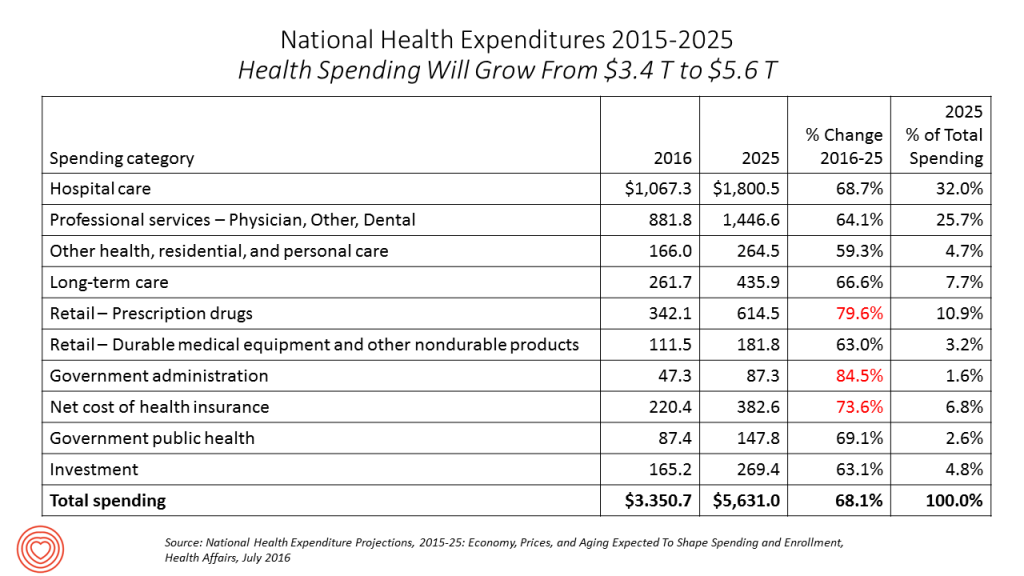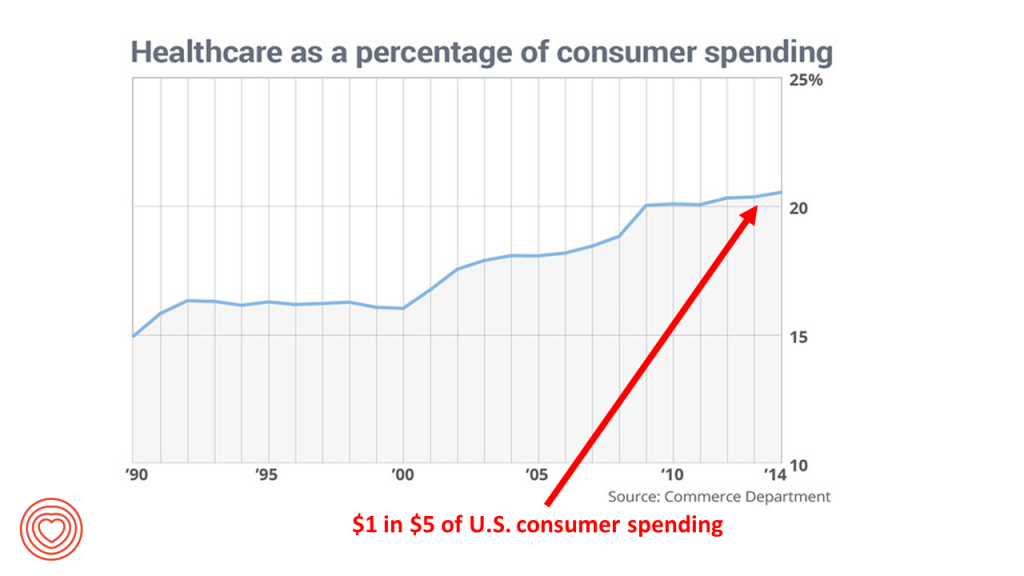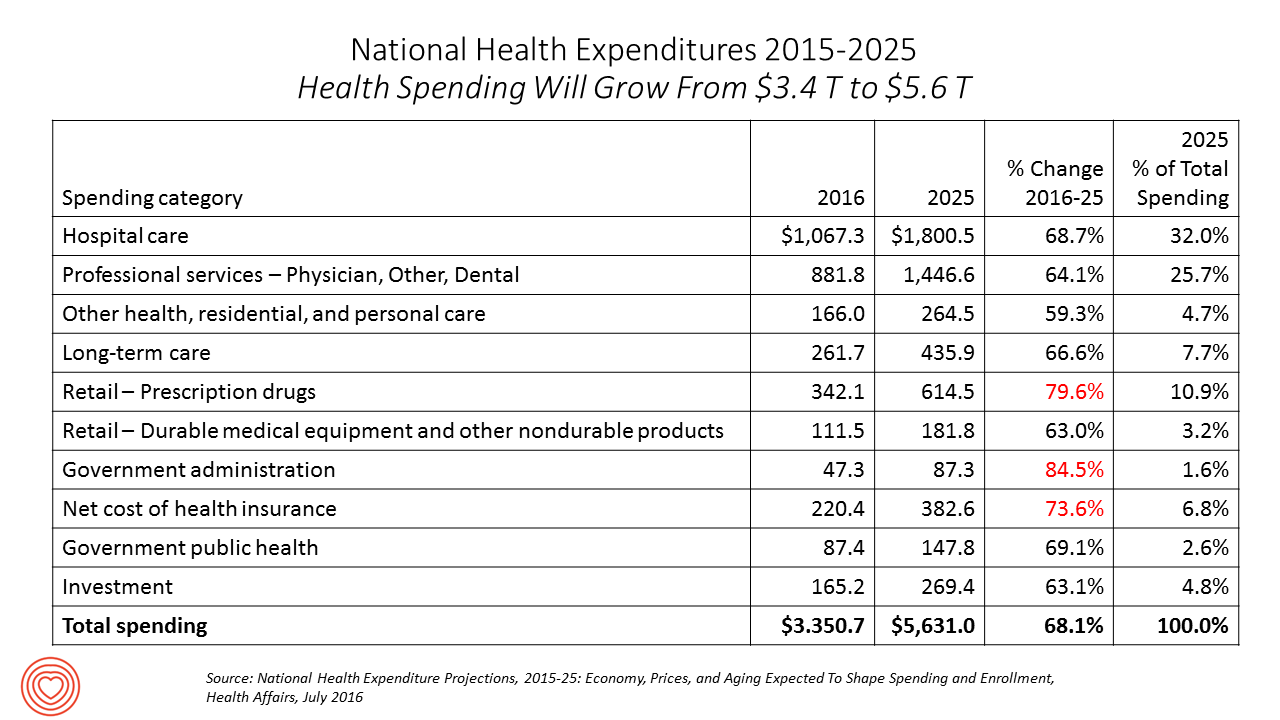 Spending on health care in America will comprise $1 in every $5 of gross domestic product in 2025, according to National Health Expenditure Projections, 2015-25: Economy, Prices, And Aging Expected to Shape Spending and Enrollment, featured in the Health Affairs July 2016 issue. Details on national health spending are shown by line item in the table, excerpted from the article.
Spending on health care in America will comprise $1 in every $5 of gross domestic product in 2025, according to National Health Expenditure Projections, 2015-25: Economy, Prices, And Aging Expected to Shape Spending and Enrollment, featured in the Health Affairs July 2016 issue. Details on national health spending are shown by line item in the table, excerpted from the article.
Health spending will grow by 5.8% per year, on average, between 2015 and 2025, based on the calculations by the actuarial team from the Centers for Medicare and Medicaid Services (CMS), authors of the study. The team noted that the Affordable Care Act’s impact in the short run has been to slow spending growth that has been a response to greater patient cost-sharing in both commercial/private health plans and in various Medicare payment regimes.
The forecast to 2025 expects that prices for health care services will increase in the middle of the 10 year projection period, pointing to continued use of high-cost specialty drugs and faster drug price growth, in addition to continued growth of Boomers aging in Medicare, and of aging disabled enrollees in Medicaid.
In the latter period of the forecast, 2020-2025, spending growth will be higher (around 6.0% per year), further spurred by the aging of America into Medicare. Per enrollee spending for Medicare will read $18,000 in 2025, CMS expects.
Several key points by spending line item are worth noting:
- Hospital prices which typically drive up overall health care spending are expected to be lower than other spending segments
- Physician and clinical services will be impacted by growing cost-sharing for patients, such as higher copayments and deductibles, and new benefit-design changes, increasing consumers’ out-of-pocket spending for this category
- Prescription drug cost increases will be influenced upward by the growth of new specialty drug approvals, but some of the impact will be tempered by some approvals for biosimilars
- Legislative reforms for Medicare will impact spending, as doctors participate in bonus payment programs starting in 2019 toward alternate payment models
- Medicaid eligibility is expected to expand, since only 31 stats and the District of Columbia have thus far expanded Medicaid in response to the Affordable Care Act.
One thing is certain: government payors at the Federal, State and local levels will be covering more health care spending.
 Health Populi’s Hot Points: In 2016, the average U.S. family is spending about $1 in every $5 household dollars on health care. This is calculated based on the individual American’s expected $10,345 spending this year divided into the median family income of around $55,000.
Health Populi’s Hot Points: In 2016, the average U.S. family is spending about $1 in every $5 household dollars on health care. This is calculated based on the individual American’s expected $10,345 spending this year divided into the median family income of around $55,000.
Looking to the next decade, CMS forecasts that the government, writ large – Federal, State, and local arms — will take on greater financial burden for health care spending. But from where do those public sector health spending dollars come?
Answer: from U.S. taxpayers, who also wear the hat of health care consumers.
Add into this additional health consumer financial burden other health/care spending that doesn’t get counted by CMS’s National Health Accounts methodology. Deloitte estimated the “hidden cost of healthcare” to be roughly another 20% of health spending on top of the National Health Expenditures, some $672 billion in 2012. That’s supervisory care for loved ones and friends, nutrition and supplements, complementary and alternative medicine services, and other non-reported spending on health-related care and activities.
CMS projects that health spending will comprise 20% of GDP by 2025. For consumers’ personal home spending, it’s already hit 20% and will be a much greater share of the pocketbook, including all health/care outlays, by 2025.





 Interviewed live on BNN Bloomberg (Canada) on the market for GLP-1 drugs for weight loss and their impact on both the health care system and consumer goods and services -- notably, food, nutrition, retail health, gyms, and other sectors.
Interviewed live on BNN Bloomberg (Canada) on the market for GLP-1 drugs for weight loss and their impact on both the health care system and consumer goods and services -- notably, food, nutrition, retail health, gyms, and other sectors. Thank you, Feedspot, for
Thank you, Feedspot, for  As you may know, I have been splitting work- and living-time between the U.S. and the E.U., most recently living in and working from Brussels. In the month of September 2024, I'll be splitting time between London and other parts of the U.K., and Italy where I'll be working with clients on consumer health, self-care and home care focused on food-as-medicine, digital health, business and scenario planning for the future...
As you may know, I have been splitting work- and living-time between the U.S. and the E.U., most recently living in and working from Brussels. In the month of September 2024, I'll be splitting time between London and other parts of the U.K., and Italy where I'll be working with clients on consumer health, self-care and home care focused on food-as-medicine, digital health, business and scenario planning for the future...